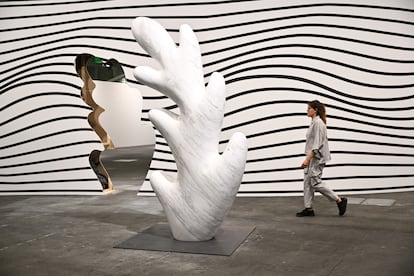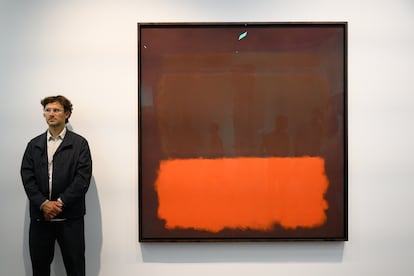Less risk and more Picasso: the art market turns to the classics to avoid the crisis.

It wasn't the best year, but it wasn't the catastrophe some predicted either. The latest edition of Art Basel , the world's most important contemporary art fair, will close its doors this Sunday with a sigh of relief. The event has not been immune to the conflict between Israel and Iran, the humanitarian crisis in Gaza, the situation in Ukraine, or uncertain economic forecasts, but it has managed to overcome the pessimism with a considerable level of sales, or at least better than certain indicators suggested. The fair's own annual report on the state of the art market found a 12% drop in sales for 2024, after several years of stability. Added to this was the fiasco of the New York auctions last month: no lot exceeded €50 million, and a Giacometti work, estimated at €70 million, went unbidden.
Outside Messeplatz, the usual venue for Art Basel, a monumental installation by Katharina Grosse stained the entrance to the venue with chaotic, blood-colored stains, as if reflecting the climate of unrest that dominated this year's edition. At noon on Tuesday, the day beforehand reserved for VIP collectors, a stroll through the ground floor, where the world's top-tier galleries are exhibiting, revealed that sales wouldn't be disastrous, but they would be slower than usual.
“It's gone better than I expected, but it's not like it was two years ago,” admitted Austrian Thaddaeus Ropac. “It's a very good start, but the context is uncertain and we don't know what implications it will have for the market,” added Marc Payot of the mega-gallery Hauser & Wirth . At her stand , Londoner Victoria Miro agreed: “I've been worried these past few days, but now I'm feeling more optimistic.” Although perhaps it was the all-powerful gallery owner Larry Gagosian who best summed up the general feeling: “Art has always been a refuge, but now no one is going to pay a stupid price.”

Art Basel's own executive director, Noah Horowitz , also acknowledged his surprise. "Neither I nor the galleries expected such a strong response," he stated in a hallway late Thursday. "Even so, we can't forget that we're still in a complicated environment. Geopolitical and economic uncertainty is a persistent backdrop." Does the leader of the world's leading art fair, which has just announced a new date in Qatar for 2026, see a new crisis on the horizon? "I don't like to make predictions, but this moment is not like previous crises, like the one in 2008. It's true that speculative buyers who paid exorbitant amounts have withdrawn, but new, younger and geographically diverse collectors have emerged, especially in the more accessible price ranges. That's encouraging."
Even so, a simple tour of the fair made it clear that the euphoria of the post-pandemic editions had faded. And this was reflected in the prices: high, but less stratospheric. Only one work exceeded €9.3 million in the first two days (four did so in the same period last year). The Annely Juda gallery sold a David Hockney canvas for between €12 and €16 million. David Zwirner auctioned a Ruth Asawa sculpture for €8.8 million and a Gerhard Richter painting for around €6.5 million. Hauser & Wirth sold two Mark Bradford paintings for €3.3 million each, and two George Condo paintings for €2.2 million. Ropac, meanwhile, sold two Baselitz oil paintings for €3 and €2 million. And Pace did particularly well: he sold a Joan Mitchell oil painting for between $14 and $19 million, although he kept a 1969 Picasso valued at around $28 million on hold, but the sale had not yet been finalized.
Among the exhibitors of the 289 galleries participating in the fair, from 42 countries, there was a clear tendency toward classicism, even to an extent. Established names predominated over riskier offerings. “Given the current situation, we focused on safe bets,” confessed gallery owner Kamel Mennour, surrounded by works by Magritte, Calder, and Dubuffet, a strategy repeated at many stands . Hauser & Wirth unexpectedly exhibited a 1962 Rothko oil painting, in orange and wine, valued between 30 and 50 million euros, which still had no buyer on Friday night.

Inflation, high interest rates, and Donald Trump 's tariff threat also influenced the decisions of many collectors. In fact, the most talked-about absence was that of major American collectors. The threat of imposing tariffs of up to 31% on Swiss imports, ultimately suspended, and the perception of a hostile institutional climate under the new administration contributed to this. This unease even permeated some works, such as the one Danh Vo presented in the Unlimited section: an American flag in the form of a half-dismantled log structure.
The galleries from Madrid and Barcelona present at the fair also shared this sense of vigilance. “I hope a crisis like the one in 2008, which was extremely harsh, doesn't happen. Although, more than a crisis, I feel like a market correction is coming after years of speculation,” opined Íñigo Navarro of the Leandro Navarro gallery, one of the six Spanish galleries present. Another gallery, Prats Nogueras Blanchard, was making its debut at this edition. “Expectations are low because the market isn't going through its best moment, but we're off to a very good start,” said Rebeca Blanchard, after selling a series of photographs by Ana Mendieta in the opening hours.
At Travesía Cuatro , Silvia Ortiz and Inés López-Quesada also perceived an initial slowdown, although they ended the week with very solid results. However, the dominant feeling must have been one of restraint: neither hysteria nor catastrophism, but rather a tense wait, a somewhat strained calm, amidst which art, for now, continues to resist.
EL PAÍS

%3Aformat(jpg)%3Aquality(99)%3Awatermark(f.elconfidencial.com%2Ffile%2Fbae%2Feea%2Ffde%2Fbaeeeafde1b3229287b0c008f7602058.png%2C0%2C275%2C1)%2Ff.elconfidencial.com%2Foriginal%2F786%2Fecd%2F4f7%2F786ecd4f7b2b99b0b70d0f0d0d06c42e.jpg&w=3840&q=100)



